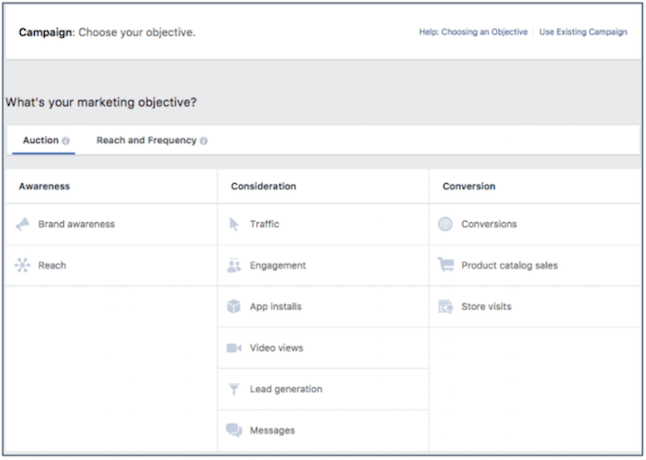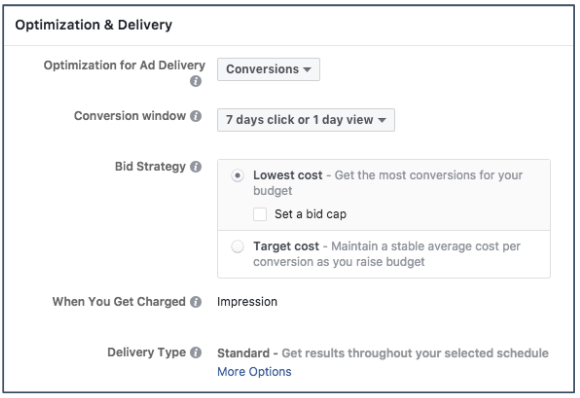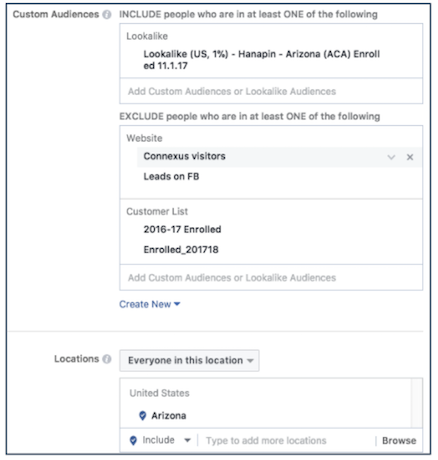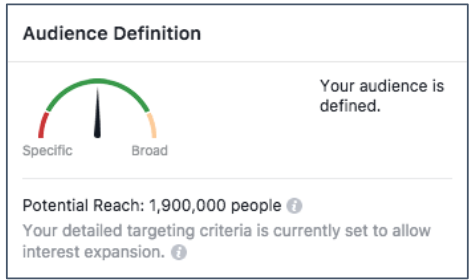Facebook has long been accepted as a great platform for B2C advertisers to reach their customers, but clients in the B2B sector have historically asked us at Hanapin Marketing whether Facebook ads would be a beneficial use of their ad spend dollars. I’m here with good news! I have seen success with B2B clients in Facebook firsthand, and it boils down to ensuring that a solid strategy is in place – a strategy designed specifically for B2B objectives. The following can serve as a roadmap for getting your B2B Facebook advertising campaigns off to the right start.
Things You’ll Need to Start
- Facebook Business Manager Account
- Social Advertising Goals/KPIs
- Conversion Tracking (Facebook Pixel)
- Creative Assets and Offerings
Campaign Objectives
The first step to creating your campaign is to choose a campaign objective. It is important to choose your objective correctly from the get-go, because your objective will determine the options you have at the further levels through the campaign creation.

Now, for B2B I have found that the best goals to work with are Brand Awareness, Traffic, Lead Gen, and Conversions (and while the Messages goal is fairly new, this may be worth a test for businesses with Messenger accounts). These will each work in tandem to create your funnel, guiding your audience down the funnel toward an eventual conversion.
Sometimes a Brand Awareness or Traffic campaign can work singularly to accomplish general goals, or they can be the first parts of a longer trip the user takes down the funnel toward a hard conversion goal. It’s best to have an idea of how you want these to work together ahead of time, because your first few campaigns will be “experimental” and will require testing, analysis, optimization, and more analysis to get an idea of what works for your business.
Some best practices:
-
Brand Awareness
- Target broad audiences whom you intend to entice with interest-piquing content. Video engagement and organic content like blog posts are great for Brand Awareness campaigns.
-
Traffic
- Do: Send traffic to a high-value page on your website. This will get you the customers who are most likely to convert, as well as customers who completed actions valuable for the creation of lookalike audiences or remarketing lists.
- Don’t: Send traffic to your facebook page. You want to eliminate friction by reducing the number of touch points between a user and an action of value for your business.
-
Lead Gen
- You can set your ad’s destination to a lead form fill page on your site. Don’t be afraid, however, to test the facebook’s lead ads option in your lead gen campaigns. They allow the user to fill out a lead form without leaving facebook, and facebook can auto-fill some of their information as well. These leads are how you will gain customer lists not only for your various CRM uses, but also for detailed facebook remarketing.
Ad Sets
You have three main areas of control at the ad set level: Budgeting/Bidding, Targeting, and Placements.
1. Budgeting & Bidding
You can set your budget to either a daily or a lifetime budget. To start, you may want to test utilizing a daily budget over a set campaign duration, because you will need an idea of how your campaigns spend and with what profitability. I have found that once I am comfortable with an account’s Facebook advertising performance in general, a lifetime budget allows Facebook’s algorithms to better optimize spend over the campaign’s run.
For bidding, you can either allow Facebook to find the most conversions for your campaign goal at your overall budget (with or without a bid cap), or you can set a CPA target. I have had the most success with CPA caps for my clients.

You can also make use of the Ad Scheduling option for Delivery to ensure that your ads will not show during times of the day that you know are not valuable for your business. This could be determined based on logic (e.g. when potential customers are unable to convert or get a hold of a point of contact) or analysis of performance in your other channels.
2. Targeting
This is where the magic really happens for B2B Facebook ad campaigns. A good thing to do before you begin thinking about targeting in Facebook ads is to identify what audiences are already working for your other paid or organic channels.
Facebook allows you to target in as broad or as detailed manners as you decide is beneficial to accomplish your goals. You aren’t targeting with keywords in Facebook, but rather you’ll target audiences that you create either at the ad set level or in the Custom Audience and Lookalike Audience interfaces (the latter two must be created before they can be implemented in your campaign targeting).
At the ad set level you can create your Core Audiences. These are where you will target to reduce your audience size based on demographics and psychographics. You have your standard location, age, gender, and language targeting. Then you can add psychographic targeting such as interests, behaviors, and more detailed demographics. I like to test ad sets with different Core Audience targeting (e.g. Interests vs. Job Titles) to determine specifically what types of core audiences work best, and too avoid getting my audience too narrow with layered targeting.

Custom Audiences will be created based on information such as your customer email lists and website traffic. These can work for remarketing efforts and to build new audiences as you bring users down the funnel. Don’t forget to utilize negative audiences (e.g. customers who visited [site page] and customers who did not convert) similar to the way you would use negative lists in AdWords remarketing.
Finally, Lookalike Audiences are a great way to use the audiences you have already built through the former two targeting methods. For example, you can create a lookalike audience for high-value customers (think: converters), and Facebook will serve your ads to people whose profiles and behaviors indicate that they are similar to those converting customers.
Best practice: Don’t get too layered on top of Lookalikes, and try to reach an audience of 500,000 or more.

3. Placements
Finally, you are able to make decisions on where you would like your Facebook ads to show. Facebook has locations on the site itself as well as Instagram and Audience Network placements. Depending on your creative assets, your brand safety/hygiene needs, and your campaign goals, you may want to opt in or out of any of these. You can utilize managed placements similarly to your placement lists (or negative lists) in AdWords. However, remember that the more placements you are opted into, the more data the algorithm has to work with in order to serve your ad to the best possible customers for your campaign objective.
Ads
The ad level is where you will set your creative assets that make sense for your target audiences within your campaign goals. Facebook has a great resource for exploring the various ad types and connecting them with different goals.
Here are my recommendations for best practices:
1. Video, video, video
I may not have to convince you that video is where it’s ad for social advertising (though this post on a video first strategy for Facebook will hopefully do the trick if so). Video consumption continues to be on the rise year over year, and the ways users are watching matter for your creative considerations.
Best practices:
- 30 seconds or less, with 15 seconds or less being ideal
- Design the video for sound off – get users’ attention even when you’re muted
- Utilize a square or 9:16 ratio to capture as much real estate as possible
- Brand Identity should be established as early as possible
2. Lead Ads
Your lead ads are accomplishing a very different purpose than your engagement/awareness ads, so be sure you know who you’re targeting with your lead ads and why. Remember that the point is to reduce friction and gain user trust (they’re giving you their personal data!)
Best practices:
- Only ask for the information you need
- Limit free-form items as much as possible
- Give 3-4 options to avoid the need for the user to scroll
- Customize your Thank You page (e.g. “Thank you, [Name]!”)
3. Carousel/Image Ads
While video and lead gen ads are on the up & up, tried and true carousel or single-image ads serve their purpose as well. Carousel ads have better performance, and you should avoid single-image ads unless your creative assets are limited. I have had success with using bold images that link the user to a client’s page that I have determined is valuable, such as a blog post that shows great organic traffic in Google Analytics. These are best for destination urls that don’t correspond to a lead form or relevant video, but make sure you are using them along with video/lead ads with a direct goal in mind.
Best practices (or Good Reasons to Use Carousel/Image Ads):
- Tell a story with your images (e.g. a case study/client success story)
- Share your resources (think: blogs and articles)
- Explain a process
- Highlight the features of your solution
Wrapping Up
This roadmap should serve as a general guide to get you started on the larger components of your Facebook advertising strategy. PPC Hero has many helpful articles about more specific aspects of Facebook ads, and once you have a few campaigns running you will find areas for detailed testing and optimization. Like any other platform, the tools available are always changing, and PPC Hero is here to keep you up-to-date on the latest and greatest in pay-per-click!



